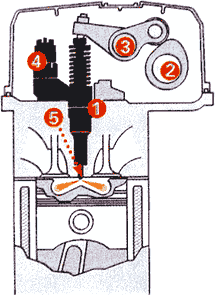
| Questions |
| CR injection system |
| VR injection system |
| PDE injection system |
| Quick guide |
| The pump-nozzle unit |
|
The demands on modern diesel engines as regards output, torque and running smoothness are growing in tandem with simultaneous demands for reductions in fuel consumption and exhaust gas emissions. For this reason, the focus is increasingly on high-pressure injection systems with EDC (Electronic Diesel Control). They have considerable advantages over conventional injection systems. The high injection pressures lead to a finer atomization of the fuel in the combustion chamber and consequently to quicker and better combustion. The cylinder output thus increases, with a lower proportion of uncombusted substances in the exhaust gas. The increased efficiency leads to lower fuel consumption. The degree of freedom electronic control affords you permits you to adjust the injection process almost at will. With the added opportunity of pilot injections or multiple injections, noise emissions can be substantially reduced. Post injections lead to a decrease in nitrogen oxide concentration in the exhaust gas. In this way, an optimum injection process can be set for any kind of operating conditions. Three systems for direct-injection diesel engines are manufactured in the industry:
If pressure rises further, the balance piston kicks into motion, freeing up an additional chamber. Pressure sinks in the nozzle chamber as a result. The nozzle spring is further prestressed by the required amount and the opening pressure rises noticeably, causing the nozzle needle to close again. When the higher opening pressure is reached, the main injection begins. It lasts until the magnet valve is reopened. The pump chamber and nozzle chamber are released of pressure and the nozzle needle closes again. A spring is responsible for the upward movement of the pump piston. The pump chamber is refilled with fuel, which remains at a fixed pressure generated by a delivery pump. The bypass plunger takes up its old position and the nozzle prestressing spring relaxes back to its original tension. Tests |
 The pressure generation unit (pump, 1), the atomization unit (nozzle, 5) and the control unit (electromagnetic valve, 4) form an assembly. Every engine cylinder has such a pump-nozzle unit, which is located in the cylinder head and is activated by means of a rocker arm (3) from the camshaft (2), which is mainly placed in the cylinder head. The delivery of the fuel occurs during the downward movement of the pump piston. The injection process begins, however, only after the closing of the magnetic valve, which is electronically controlled. The flowing of the fuel into the low-pressure system is interrupted. A rapid rise in pressure occurs in the pump chamber and nozzle chamber. After the nozzle opening pressure has been reached, the lifting of the nozzle needle begins, followed by the pilot injection.
The pressure generation unit (pump, 1), the atomization unit (nozzle, 5) and the control unit (electromagnetic valve, 4) form an assembly. Every engine cylinder has such a pump-nozzle unit, which is located in the cylinder head and is activated by means of a rocker arm (3) from the camshaft (2), which is mainly placed in the cylinder head. The delivery of the fuel occurs during the downward movement of the pump piston. The injection process begins, however, only after the closing of the magnetic valve, which is electronically controlled. The flowing of the fuel into the low-pressure system is interrupted. A rapid rise in pressure occurs in the pump chamber and nozzle chamber. After the nozzle opening pressure has been reached, the lifting of the nozzle needle begins, followed by the pilot injection.